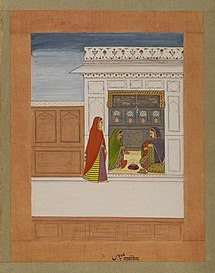This article needs additional citations for verification. (November 2013) |
Pausha (Sanskrit: पौष Pauṣa; Hindi: पूस Pus; Tamil: தை Tai), also called Paush, Poush, Pausa or Pushya, is the tenth month of the Hindu calendar, corresponding with December/January of the Gregorian calendar. In the Indian national calendar, Pausha is also the tenth month of the year, beginning on 21 December and ending on 19 January.[1]
| Pausha | |
|---|---|
 Brooklyn Museum - Month of Pausha, page from a Baramasa series | |
| Native name | पौष (Sanskrit) |
| Calendar | Hindu calendar |
| Month number | 10 |
| Season | Winter |
| Gregorian equivalent | December-January |
| Significant days | |
In the Hindu lunisolar calendar, Pausha begins with either the full or new moon around the same time of year. Since the traditional Hindu calendar follows the lunar cycle, Pausha's start and end dates vary from year to year, unlike the months of the Hindu solar calendars. Pausha is a winter (Hemanta and Shishira Ritu) month.[2][3] The lunar month of Pausha overlaps with the solar month of Dhanu.[4][5]
Events
editPausa Bahula Amavasya day is celebrated as Theppotsavam (float festival) at Sri Varaha Lakshmi Narasimha Swamyvari Temple in Simhachalam. The Utsava idols are taken in a palanquin to Varaha Pushkarini.[6]
| Shukla Paksha | Krishna Paksha |
|---|---|
| 1. Prathama | 1. Prathama |
| 2. Dwitiya | 2. Dwitiya |
| 3. Tritiya | 3. Tritiya |
| 4. Chaturthi | 4. Chaturthi |
| 5. Panchami | 5. Panchami |
| 6. Shashti | 6. Shashti |
| 7. Saptami | 7. Saptami |
| 8. Ashtami | 8. Ashtami |
| 9. Navami | 9. Navami |
| 10.Dashami | 10.Dashami |
| 11.Ekadashi | 11.Ekadashi |
| 12.Dwadashi | 12.Dwadashi |
| 13.Thrayodashi | 13.Thrayodashi |
| 14.Chaturdashi | 14.Chaturdashi |
| 15.Purnima | 15. Amavasya |
See also
editReferences
edit- ^ Henderson, Helene. (Ed.) (2005) Holidays, festivals, and celebrations of the world dictionary Third edition. Electronic edition. Detroit: Omnigraphics, p. xxix. ISBN 0-7808-0982-3
- ^ James G. Lochtefeld (2002). The Illustrated Encyclopedia of Hinduism: A-M, N-Z (Vol 1 & 2). The Rosen Publishing Group. pp. 508. ISBN 978-0-8239-3179-8.
- ^ Robert Sewell; Śaṅkara Bālakr̥shṇa Dīkshita (1896). The Indian Calendar. S. Sonnenschein & Company. pp. 5–11, 23–29.
- ^ Christopher John Fuller (2004). The Camphor Flame: Popular Hinduism and Society in India. Princeton University Press. pp. 291–293. ISBN 978-0-69112-04-85.
- ^ Robert Sewell; Śaṅkara Bālakr̥shṇa Dīkshita (1896). The Indian Calendar. S. Sonnenschein & Company. pp. 10–11.
- ^ Teppotsavam. "Festivals". Simhachalam Devasthanam. Retrieved 24 June 2016.